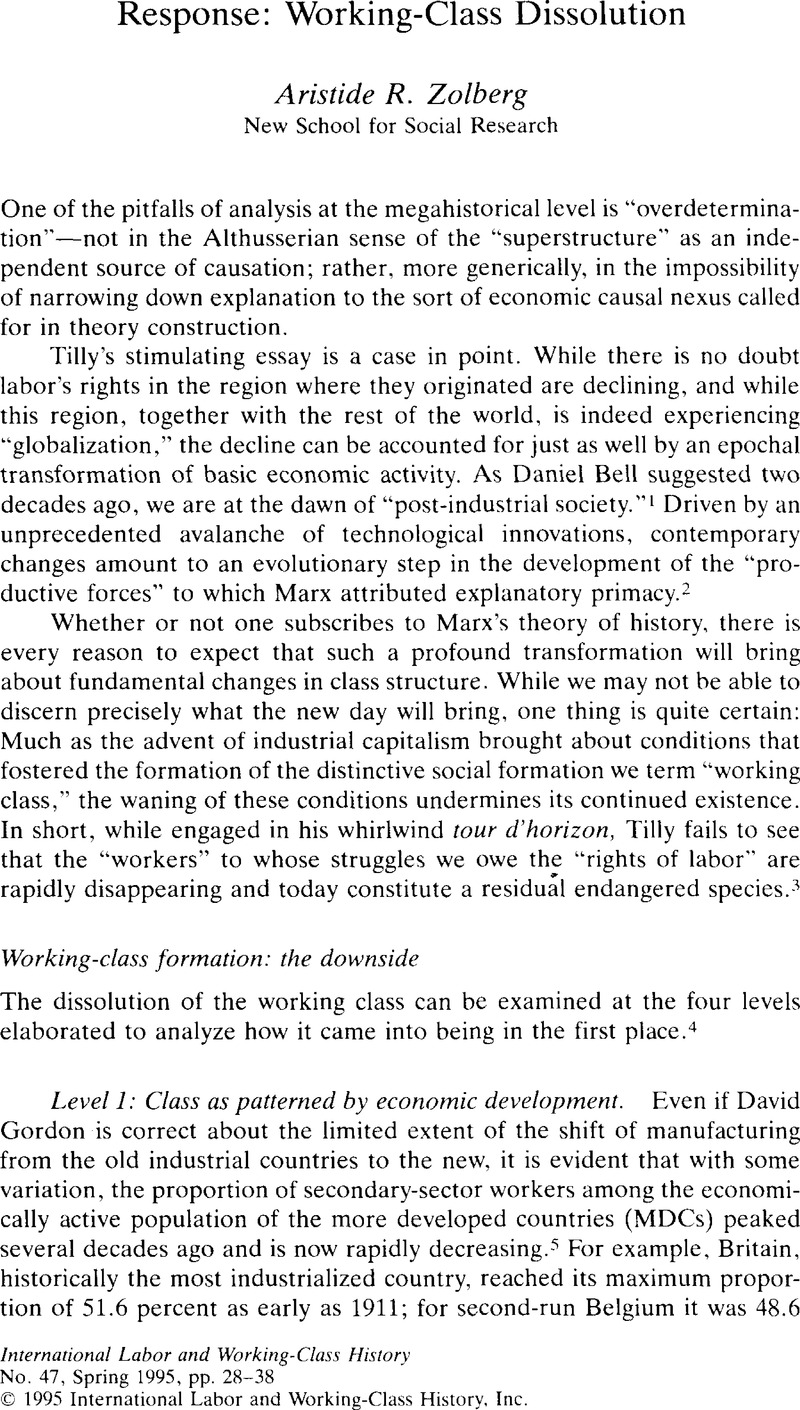Article contents
Response: Working-Class Dissolution
Published online by Cambridge University Press: 16 December 2008
Abstract

- Type
- Responses
- Information
- Copyright
- Copyright © International Labor and Working-Class History, Inc. 1995
References
NOTES
1. Bell, Daniel, The Coming of Post-Industrial Society: A Venture in Social Forecasting (New York, 1973), 165–265.Google Scholar
2. Cohen, Gerald A., Karl Marx's Theory of History: A Defence (Princeton, 1978).Google Scholar
3. In keeping with Przeworski and others, “workers” and “labor” refer by and large to what are called in the United States “blue-collar workers,” involved principally in manufacturing and the “secondary sector” more generally.
4. Katznelson, Ira and Zolberg, Aristide, eds., Working Class Formation: Nineteenth Century Patterns in Western Europe and North America (Princeton, 1986).Google Scholar
5. Gordon, David, “The Global Economy: New Edifice or Crumbling Foundations?” New Left Review 168 (1988): 24–65.Google Scholar
6. Eycken, H. Vander and Frantzen, P., De Tertiaire Sector (Brussels, 1970), 16–23.Google Scholar
7. Center for European Studies, Welfare in a Civil Society (Vienna, 1994), 266–67.Google Scholar
8. I am here applying the analysis of North, Douglass C. and Robert, Paul Thomas, The Rise of the Western World: A New Economic History (London, 1973).CrossRefGoogle Scholar
9. Hamilton, Richard, Affluence and the French Worker in the Fourth Republic (Princeton, 1967). It should be noted that this study was based on survey research conducted in 1956.CrossRefGoogle Scholar
10. Przeworski, Adam and Sprague, John, Paper Stones: A History of Electoral Socialism (Chicago, 1986), 38, 40.Google Scholar
11. Ibid., Table 2.5, 39.
12. The concept is borrowed from Jim Scott.
13. Przeworski and Sprague, Paper Stones, 184.
14. Ibid., 185.
15. Thomas, Brinley, Migration and Economic Growth: A Study of the Atlantic Economy (London, 1973).Google Scholar
16. This was expressed by Keir Hardie at the constitutive meeting of the Second International. Joll, James, The Second International, 1889–1914 (New York, 1966), 37.Google Scholar
17. Gourevitch, Peter, Politics in Hard Times (Ithaca, 1986). It should be noted that Gourevitch does not examine the role of labor, if any, in determining policy responses.Google Scholar
18. The New York Council on Foreign Relations, largely reflecting the outlook of American high finance, played a key role in elaborating and disseminating this doctrine. See Kirshner, Orrin, “The Mounting Difficulties of World Trade Leadership: The Politics of American Trade Policy since World War II” (Ph.D. diss., New School for Social Research, 1994).Google Scholar
19. In this regard, the key work is Schumpeter's, Joseph contemporaneous Capitalism, Socialism, and Democracy (New York, 1949).Google Scholar
20. Ruggie, John G., “International Regimes, Transactions, and Change: Embedded Liberalism in the Postwar Economic Order,” in International Regimes, ed. Krasner, Stephen D. (Ithaca, 1983);Google ScholarMaier, Charles, In Search of Stability (Cambridge, 1987), 121–52.Google Scholar
21. Katzenstein, Peter, Small States in World Markets: Industrial Policy in Europe (Ithaca, 1985).Google Scholar
22. Esping-Andersen, Gosta, The Three Worlds of Welfare Capitalism (Princeton, 1990).Google Scholar
23. Marshall, T.H., Class, Citizenship, and Social Development (Chicago, 1977; orig. 1964).Google Scholar
- 12
- Cited by




